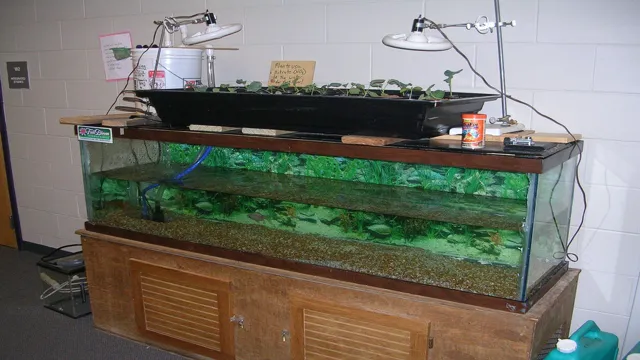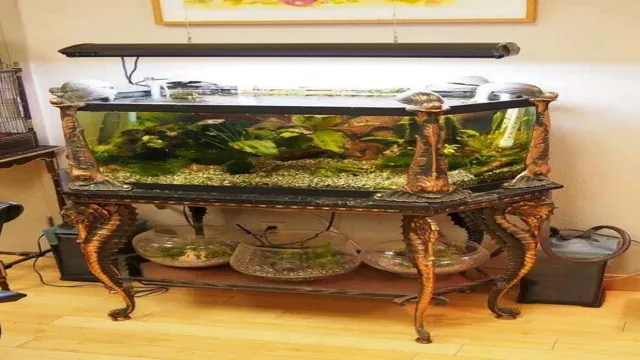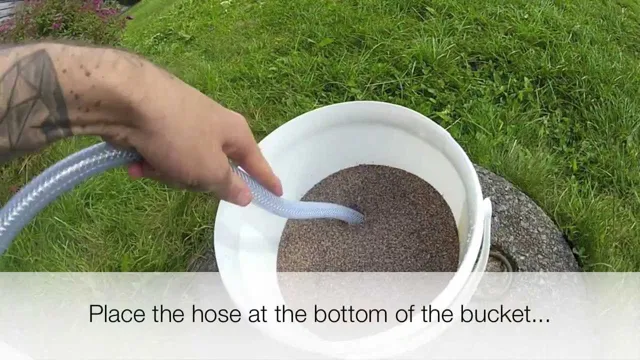How to Feed Plants in an Aquarium for Optimal Growth: The Complete Guide

Are you an aquarium enthusiast looking to keep your plants healthy and thriving? Well, look no further because we’ve got you covered! Feeding plants in an aquarium is not as simple as just throwing in some fish food and hoping for the best. Just like how you wouldn’t feed a horse like you would feed a cow, each species of aquatic plant has specific nutritional needs that must be met in order for them to prosper in a closed environment. Think of it this way: just like how humans can’t live on a diet of only chips and candy, aquatic plants need a balanced and diverse diet to grow and thrive.
That’s why we’ve put together this guide to give you the inside scoop on everything you need to know about feeding your plants in an aquarium. From the nutrients they need to the different types of fertilizers, we’ve got you covered. So, get ready to learn about the different stages of plant growth, the ideal conditions for photosynthesis, and the importance of providing your aquatic plants with a well-rounded diet.
By the end of this guide, you’ll have all the information you need to become a pro at feeding your aquarium plants. Get your green thumbs ready!
Understanding Plant Nutrition
If you have an aquarium, you know that feeding your fish is essential, but did you know that plants in your tank also need to be fed? Understanding plant nutrition can be a bit confusing, but there are a few simple steps you can take to ensure your aquatic plants are healthy and thriving. First and foremost, make sure your plants are getting enough light. Without adequate light, plants cannot undergo photosynthesis, which is crucial for their growth.
Additionally, plants need a source of carbon, which can be provided through liquid or substrate fertilizers. Finally, it’s important to pay attention to the nutrient levels in your aquarium water and adjust accordingly with supplements such as potassium, calcium, and magnesium. By taking these steps and feeding your plants in the same way you feed your fish, you can maintain a beautiful and healthy aquatic environment.
The Role of Macronutrients
Macronutrients are essential for the growth and development of plants. Understanding plant nutrition is crucial for any gardener or farmer to achieve healthy and thriving plants. The three primary macronutrients are nitrogen, phosphorus, and potassium, commonly referred to as NPK.
Nitrogen is vital for the synthesis of amino acids, proteins, and chlorophyll, which is necessary for photosynthesis. Phosphorus is required for cell division and energy transfer, which is critical for root development and flowering. Potassium plays a crucial role in regulating water uptake and nutrient transportation, improving plant resilience against environmental stresses such as droughts and diseases.
Maintaining a balanced and adequate supply of these macronutrients is crucial for optimum plant growth, health, and yield. Understanding the role of each macronutrient and ensuring that plants receive the right amount is vital for producing healthy and nutrient-rich produce.

The Role of Micronutrients
Micronutrients play a crucial role in plant nutrition, and understanding their importance is essential for every farmer and gardener. Micronutrients are essential elements that plants require in small quantities for their growth and development. These micronutrients, including iron, manganese, zinc, copper, boron, and molybdenum, are essential for a plant’s metabolic functions, including photosynthesis, enzyme activation, and hormone production.
Just like how humans require vitamins and minerals for proper growth and development, plants need these micronutrients in the correct amount to achieve optimal growth and yield. While macronutrients like nitrogen, phosphorous, and potassium are a plant’s primary nutrient needs, micronutrients often get overlooked and neglected. A deficiency in any micronutrient can lead to significant growth issues like stunted growth, yellowing of leaves, and reduced plant resistance to pests and diseases.
Therefore, it is crucial to maintain a balanced and diverse nutrition program, including all the necessary macronutrients and micronutrients for better plant health and growth. A healthy and well-nourished plant means higher yields and better quality produce, making it a smart investment for any farmer or gardener.
Choosing the Right Fertilizer
Choosing the right fertilizer is key in maintaining a healthy aquarium ecosystem for your aquatic plants. When it comes to feeding plants in an aquarium, it is important to consider the nutrients that your plants need to thrive. Nitrogen, phosphorus, and potassium are the primary macronutrients that are essential for plant growth, but your plants may also require micronutrients such as iron, calcium, and magnesium.
It is important to choose a fertilizer that includes all of these nutrients in the right amounts. Liquid fertilizers are generally the easiest to use since they can be easily added to the water and will dissolve quickly. Be sure to follow the manufacturer’s directions and avoid over-fertilization, which can lead to harmful algae growth.
By choosing the right fertilizer and correctly feeding your plants, you’ll be on your way to growing a lush and healthy aquatic garden in your aquarium.
Liquid Fertilizers vs. Substrate Fertilizers
Choosing the right fertilizer can be a daunting task. Liquid fertilizers and substrate fertilizers are two popular options with distinct differences. Liquid fertilizers are essentially a mix of nutrients that are diluted in water and can be easily sprayed onto the plants.
They are ideal for quick results as the plant can easily absorb the nutrients through its leaves. However, they require frequent application as they are quickly washed away by rain or watering. On the other hand, substrate fertilizers are added to the soil or substrate and release nutrients slowly over time.
This means they only need to be applied once and can provide long-term benefits to the plant. However, they are less effective in providing quick nutrients and require some knowledge about the plant’s need for nutrients. Choosing the right fertilizer depends on the specific needs of each plant.
For fast-growing plants that require quick nutrients, liquid fertilizers are ideal. But, for long-term growth and maintenance, substrate fertilizers are a better option. It is also important to consider the growing medium, whether it’s soil or substrate, and the specific nutrient needs of the plant.
In conclusion, the choice between liquid fertilizers and substrate fertilizers depends on the type of plant and specific needs. Each type has its advantages and disadvantages, and it’s important to consider the growing medium and nutrient requirements of the plant. With proper research and understanding, choosing the right fertilizer can go a long way in promoting healthy plant growth.
NPK Ratios and Their Importance
When it comes to choosing the right fertilizer for your plants, understanding NPK ratios is key. NPK stands for nitrogen, phosphorus, and potassium, which are three essential nutrients that are required for plant growth. The ratio of these nutrients in your fertilizer can have a big impact on how your plants grow and develop.
For example, if you want to encourage leafy growth, you’ll want a fertilizer that is high in nitrogen. On the other hand, if you’re looking to encourage root growth or budding, you’ll want a fertilizer that is higher in phosphorus and potassium. It’s important to select a fertilizer that is appropriate for your specific plants and their stage of growth.
Once you understand the basics of NPK ratios, you’ll be better equipped to choose a fertilizer that will help your plants thrive.
Using CO2 for Plant Growth
CO2 for Plant Growth, Fertilizer When it comes to using CO2 for plant growth, choosing the right fertilizer is key to ensuring healthy and thriving crops. Fertilizers are essential for providing plants with the necessary nutrients they need to grow and produce. However, not all fertilizers are created equal.
It’s important to consider factors such as the type of plant, the stage of growth, and the soil conditions when selecting a fertilizer. For example, some plants may require more nitrogen or potassium, while others may need more phosphorous or calcium. Additionally, the pH level of the soil can affect the availability of certain nutrients.
Organic fertilizers, such as compost and manure, can improve soil quality and nutrient content, while synthetic fertilizers may contain harmful chemicals. Ultimately, choosing the right fertilizer depends on the specific needs of the plants and the environment in which they are growing.
Applying Fertilizer to Your Aquarium Plants
Keeping aquarium plants healthy and vibrant requires proper feeding. Just like any other plant, aquarium plants require nutrients to thrive, and fertilizer is the primary source of those nutrients. When applying fertilizer to your aquarium plants, it’s essential to use a slow-release fertilizer that won’t harm your fish or other aquatic animals.
The best way to feed your plants is by using a liquid fertilizer that you can infuse into the water. You should also take note of the fertilizer schedule provided by the manufacturer and stick to it. Overfertilization can cause an imbalance in the aquarium’s ecosystem, leading to algae blooms, which can be harmful to your plants and animals.
By ensuring the right dosage and a consistent schedule, your plants will grow strong, and your aquarium will thrive with a plethora of colors and life. In summary, feeding your aquarium plants is essential to their growth, and the key to doing it properly is using a slow-release liquid fertilizer in the right amount at the right time.
Dosage and Frequency
When it comes to fertilizing your aquarium plants, it’s important to understand how much to use and how often to apply it. Dosage and frequency depend on factors like the type of plants you have, the size of your aquarium, and the type of fertilizer you’re using. As a general guideline, most aquatic plant fertilizers recommend a dosage of one milliliter per ten gallons of water, applied once a week.
It’s crucial not to over-fertilize your plants, which can lead to algae growth and harm your fish. Remember that plants can only absorb a certain amount of nutrients, so more isn’t always better. Always follow the manufacturer’s instructions and observe your plants’ growth response to determine if you need to adjust the dosage or frequency.
By providing your plants with the right amount of nutrients, you’ll help them thrive and keep your aquarium looking beautiful.
How to Spot and Treat Fertilizer Imbalances
Applying fertilizer to your aquarium plants can help them grow healthier and stronger. However, it’s important to know how to spot and treat fertilizer imbalances, as too much or too little of certain nutrients can harm your plants or lead to algae growth. One key factor to consider is the ratio of nitrogen (N), phosphorus (P), and potassium (K) in your fertilizer.
If your plants are showing yellowing leaves, it could be a sign of a nitrogen deficiency, while brown or burnt leaf tips may indicate too much phosphorus or potassium. To correct these imbalances, you can adjust the amount or type of fertilizer you use, or try using a complete all-in-one fertilizer specifically designed for aquarium plants. It’s also important to monitor your water quality and perform regular water changes to prevent nutrient buildup and maintain a healthy aquatic environment.
By taking these steps, you can enjoy thriving aquarium plants and a beautiful underwater ecosystem.
Conclusion: Happy and Healthy Aquarium Plants
After learning the ins and outs of feeding plants in an aquarium, it’s clear that just like us, plants need a balanced diet too. By providing a well-rounded mix of nutrients, light, and carbon dioxide, your aquatic flora will flourish and add a vibrant, natural touch to your underwater oasis. Just remember, a happy plant makes for a happy tank.
So keep those nutrients coming and watch your aquarium garden grow!”
FAQs
What is the best method for feeding plants in an aquarium?
The best method for feeding plants in an aquarium is to use liquid plant fertilizer. This can be added directly to the water, preferably in small amounts on a regular basis.
How often should I feed my plants in an aquarium?
The frequency of feeding plants in an aquarium depends on the type of fertilizer used. Generally, liquid plant fertilizer should be added once or twice a week, while root tabs can be added every 3 to 4 months.
Can I overfeed my aquarium plants?
Yes, it is possible to overfeed aquarium plants. Overfeeding can lead to algae growth and degradation of water quality. It is important to follow the instructions on the fertilizer packaging and avoid adding too much.
Is it necessary to supplement plant growth with CO2?
While it is not necessary, supplementing plant growth with CO2 can promote faster and healthier plant growth in the aquarium. This is especially important for more demanding plant species.
Should fertilizer be added directly to the substrate or water column?
It depends on the type of fertilizer used. Root tabs should be placed directly into the substrate, while liquid plant fertilizer can be added directly to the water column.
Can plants survive without fertilizer in an aquarium?
Some hardy plant species can survive without fertilizer, but most plants will benefit from regular fertilization to promote healthy growth and prevent nutrient deficiencies.
Can tap water be used to fertilize aquarium plants?
Tap water can contain some nutrients that plants can use, but it is not a reliable source of fertilizer. Liquid plant fertilizer or root tabs are recommended for providing a consistent source of nutrients to the plants.






